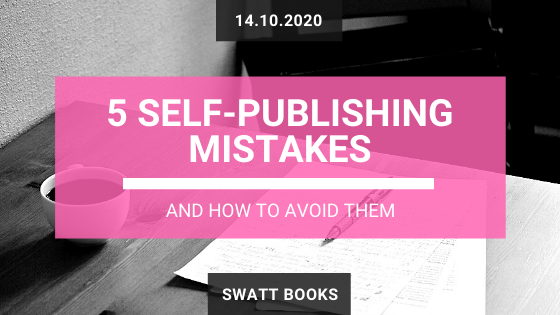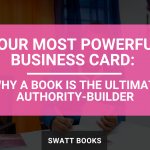Let’s be honest, in the late 2000s self-publishing had a pretty bad reputation. With the introduction of free online self-publishing services like CreateSpace, anyone could publish a book with just a few clicks of the mouse with little thought as to the quality of what they were releasing. The market was suddenly flooded with books that were riddled with mistakes that broke all the cardinal rules that the publishing industry had honoured for over a century.
But times have changed, and independent authors are now starting to understand the value of taking traditional publishing practices and combining them with the agility, control, and ownership that comes with self-publishing. So, if you want to self-publish a professional quality book that can compete with traditionally published titles and not get lumped in with all the “bad” self-published books out there, then here are the top 5 self-publishing mistakes that you need to avoid.
1. No Editing
At the very top of our list of self-publishing mistakes is no Editing. Having your book professionally edited is the golden rule of publishing regardless of whether you are self-publishing or working with a traditional publisher. The majority of readers will not be able to look past poor writing. You could be writing about something that could fundamentally change the readers’ life forever, but if your writing is littered with mistakes or doesn’t flow very well, you’ve lost your credibility in your readers’ eyes and it’s unlikely that they will even finish reading it.
But all editors are not created equal, so don’t try to save a bit of money by hiring just any old’ editor. Editing a book requires a particular set of editing skills that are very different from editing a website or sales copy. To make sure that you are publishing the best version of your book that you can, hire an editor who is a member of the Chartered Institute of Editing & Proofreading (CIEP). CIEP certified editors must adhere to a set of editorial standards and codes of practice, and you can be assured that they have the training and experience needed to make sure your writing is polished and professional whilst still maintaining your ‘voice’.
For more information on the Chartered Institute of Editing & Proofreading, or to search their director of professional editors, visit https://www.ciep.uk.
2. ISBN Ownership
Second in our list of self-publishing mistakes is one that I see far too many authors make, and that is not being mindful of who owns the ISBN number that is assigned to your book when it’s published. As ISBN ownership is not an assertion of copyright, a lot of authors get tempted by online publishing services like Amazon KDP that offer to assign your book a free ISBN as opposed to buying one of their own. The problem with this is that whoever owns the ISBN is listed as the publisher of record for that title. So, if you opted to use the free ISBN offered to you by Amazon KDP (for example), Amazon would be listed as the publisher and NOT you. Kinda defeats the purpose of self-publishing, doesn’t it?
Most readers won’t notice or care who the listed publisher of a book is, but the trade book industry does care. Many retailers will not stock books published by Amazon as they view it as supporting a direct competitor. So, if you don’t want your book to be associated with poor-quality self-publishing, then take the time to register your own publishing imprint and purchase your ISBNs. If you’re clever about the publishing imprint name that you choose, you can make your book indistinguishable from traditionally published titles. For the sake of £164 (and 20 minutes of your time), it’s well worth it.
For more information on ISBNs, check out my article “ISBN Numbers: Everything You Need to Know”
3. Amateur Cover Art
Number three in our list of common self-publishing mistakes I see authors make is not investing in professional cover design.
We’ve all heard the adage “Don’t judge a book by its cover”, but as a relatively unknown author, that is exactly what most people will be using to judge whether your book is right for them or not. Think about how you buy books these days… you search Amazon or browse through a particular category. When you see a cover thumbnail or title that piques your interest, you click through to find more information.
If your cover doesn’t stand out from the others that it will be listed with, most people won’t get to the point of even finding out what your book is about, let alone getting a sense of whether it is any good or not. If you want organic sales of your book, you need to have an eye-catching cover that converts. And that takes skill.
The good news is that professional cover design doesn’t have to be expensive. I, and many of my clients, use a service called 99 Designs where you can host a design contest for your book cover. For as little as £239 you get dozens of potential designs submitted by reputable and talented cover designers from all over the world for you to choose from.
For more information on 99 Designs and to start your own cover design contest, visit https://99designs.co.uk.
4. Poor Typesetting
Fourth in our list of self-publishing mistakes is one that is not as immediately critical as bad cover design, having a badly typeset interior for your book can be just as big a self-publishing mistake. Because most people buy books online now, having an interior that looks like an exported Word document with misaligned margins, a myriad of conflicting fonts, and clipart images that look like they were generated in PowerPoint may not have an immediate effect on the sale for your book, it can have a dramatic effect on the ongoing success of your book.
Think back to when you used to buy books in brick and mortar bookstores… when you picked a book up off the shelf, the first thing you did was usually turn it over and if you were intrigued by what you read on the back you’d probably flick through a few pages and possibly look over the table of contents, right? But with online book sales, you don’t have the option of doing that. Sure, Amazon does it’s best to mitigate that by offering their ‘Look Inside’ feature, but it’s not quite the same. (Pro Tip: make sure that your book is compatible with the ‘Look Inside’ feature on Amazon and enable the feature if you’re publishing outside of Amazon… it does make a difference to your sales). So the first opportunity you get to flick through a book is once it arrives in the post.
Some may argue that you’ve already bought the book by then, so how cares what the inside looks like. But if you flick through a book that you’ve just spent £10-£15 on and you’re a bit disappointed when you first flick through it, you’ve experienced a negative response to that book before you’ve ever read a single word of it. Subconsciously that response could colour your impression of the book even after you’ve read it, and might even prompt you to leave it a negative review… or worse yet, no review at all.
THAT is the power of professional typesetting. Ensure that your book is judged on the merits of the content and not allowing the reader to get distracted by the design (or lack of it). And in today’s online consumer market, most products from books to boats live and die by customer reviews and social proof. Make sure that a readers’ experience with your book is positive from start to finish and they will reward you by telling other people about it.
5. Limited Distribution
To round off our list of self-publishing mistakes is on I see far too many independent authors make which is to limit the availability and distribution of their book to just Amazon.
Sure, Amazon is the largest book retailer in the world; you’d be mad to NOT have your book listed on their site. However, you are equally mad to ONLY list your book on their site. Not everyone who actively shops online have an Amazon account. With an increasing backlash against them in the US media, rumours of anti-trust proceedings being brought against them and a growing trend of ‘shop local’ campaigns, more and more people are looking for alternative retailers to buy from. If your book is not available to buy from where people want to shop, then you are potentially cutting off a percentage of your readership.
Now it used to be those wider distribution models were the sole remit of big publishing houses, but no longer. Self-publishing aggregates like IngramSpark allow for simple worldwide print-on-demand distribution into over 30,000 online retailers across the globe as well as eBook distribution across multiple platforms such as Nook, Kobo and iBooks as well as Kindle.
I also touched on another point of distribution when I discussed ISBNs, and that is that high street brick and mortar book shops will not stock books via Amazon. If you want the overwhelming joy of seeing your book on an actual bookstore bookshelf, then you have to think like a traditional publisher and go wide with your distribution.
To learn more about the wide distribution model and how it relates to self-published books, check out my article “Book Distribution: How to Go Wide”.
Conclusion
So there you have it; my list of the top 5 self-publishing mistakes and a brief insight into how you can avoid making them with your next book.
Ultimately, if you want your book to be taken seriously and have the ability to compete with titles published by more traditional publishing houses, then you need to think like a traditional publisher. Invest in professional author services to help you with the things that are not your forte – like editing, design and typesetting. And if you need help to pull it all together or you are feeling a bit overwhelmed by just how much there is to think about, then Book a Call with me. Over a digital coffee, we’ll chat about your book and how I can help you avoid all of the mistakes I’ve just mentioned as well as many more.





